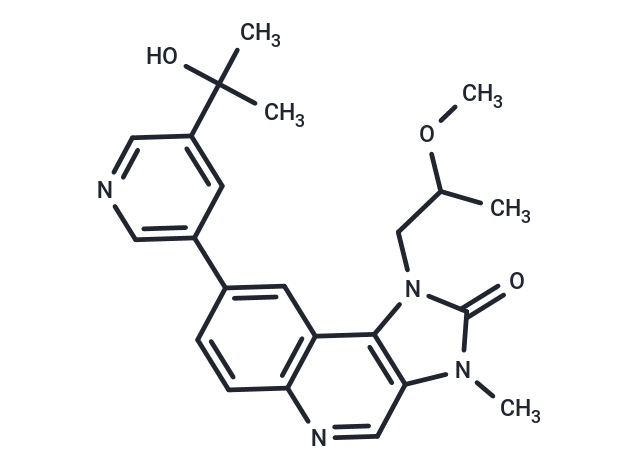Shopping Cart
- Remove All
 Your shopping cart is currently empty
Your shopping cart is currently empty

Samotolisib (LY3023414) is an oral ATP competitive inhibitor of the class I PI3K isoforms, DNA-PK, and mTOR. Samotolisib (LY3023414) has been used in trials studying the treatment of Neoplasm, Solid Tumor, COLON CANCER, BREAST CANCER, and Advanced Cancer, among others.

| Pack Size | Price | Availability | Quantity |
|---|---|---|---|
| 5 mg | $41 | In Stock | |
| 10 mg | $70 | In Stock | |
| 25 mg | $155 | In Stock | |
| 50 mg | $270 | In Stock | |
| 100 mg | $398 | In Stock | |
| 200 mg | $566 | In Stock | |
| 1 mL x 10 mM (in DMSO) | $47 | In Stock |
| Description | Samotolisib (LY3023414) is an oral ATP competitive inhibitor of the class I PI3K isoforms, DNA-PK, and mTOR. Samotolisib (LY3023414) has been used in trials studying the treatment of Neoplasm, Solid Tumor, COLON CANCER, BREAST CANCER, and Advanced Cancer, among others. |
| Targets&IC50 | PI3Kδ:38 nM, PI3Kβ:77.6 nM, DNA-PK:4.24 nM, PI3Kα:6.07 nM, PI3Kγ:23.8 nM, mTOR:165 nM |
| In vitro | Samotolisib shows high solubility across a wide pH range. In vitro, inhibition of PI3K/AKT/mTOR signaling by Samotolisib causes G1 cell-cycle arrest and resulted in broad antiproliferative activity in cancer cell panel screens. In cell-based assays, Samotolisib inhibition of PI3K and mTOR is assessed in the PTEN-deficient U87 MG glioblastoma cell line. Samotolisib inhibits the phosphorylation of AKT at position T308 downstream of PI3K at an IC50 of 106 nM. Similarly, Samotolisib inhibits phosphorylation of AKT at position S473 (IC50 = 94.2 nM) by mTORC2 as well as phosphorylation of mTORC1 kinase targets p70S6K (position T389; IC50 =10.6 nM) and 4E-BP1 (positions T37/46; IC50 = 187 nM). The downstream phosphorylation of S6RP at positions pS240/244 (IC50 = 19.1 nM) by p70S6K was inhibited as well, indicating target inhibition along the entire PI3K/AKT/mTOR pathway by Samotolisib[1]. |
| In vivo | In vivo, Samotolisib demonstrates high bioavailability and dose-dependent dephosphorylation of PI3K/AKT/mTOR pathway downstream substrates such as AKT, S6K, S6RP, and 4E-BP1 for 4 to 6 hours, reflecting the drug's half-life of 2 hours. Intermittent target inhibition is sufficient for its antitumor activity. Samotolisib shows time- and dose-dependent target inhibition in vivo. It is currently being evaluated in phase 1 and 2 trials for the treatment of human malignancies[1]. |
| Kinase Assay | Western blot analysis: The phosphorylation status of c-Met and VEGFR-2 is detected by Western blot analysis. For c-Met, MKN45 cells are incubated with a serial dilution of E7050 in complete medium at 37 °C for 2 h. For VEGFR-2, HUVEC are starved with human endothelial serum free medium containing 0.5% FBS for 24 h. Subsequently HUVEC are incubated with a serial dilution of E7050 for 1 h and then incubated with 20 ng/mL of human VEGF for 5 min. Cells are lysed by lysis buffer (50 mM HEPES [pH 7.4], 150 mM NaCl, 10% glycerol, 1% Triton X-100, 1.5 mM MgCl2, 1 mM EDTA [pH 8.0], 100 mM NaF, 1 mM phenylmethylsulfonyl fluoride 1 mM sodium orthovanadate, 10 μg/mL aprotinin, 50 μg/mL leupeptin, and 1 μg/mL pepstatin A). The resected tumor samples are homogenized with lysis buffer containing 25 mM β-glycerophosphate and 0.5% (v/v) phosphatase inhibitor cocktail 2 at 4 °C. Cellular debris is removed by centrifugation at 17 860 g for 20 min at 4 °C. Aliquots of the supernatants containing 5-20 μg of protein are subjected to SDS-PAGE under reducing conditions. The proteins are then transferred onto PVDF membranes, blocked with TBS containing 0.05% Tween-20 and either 5% skim milk or 5% BSA. The membranes are probed with the following antibodies: anti-c-Met polyclonal antibody (C-28) and anti-VEGFR-2 polyclonal antibody (C-20); mouse anti-phosphotyrosine clone 4 g10; and anti-VEGFR-2 polyclonal antibody, anti-phospho-VEGFR-2 (Tyr996) polyclonal antibody, and anti-phospho-c-Met (Tyr1234/1235) polyclonal antibody. Detection is performed using a Super Signal enhanced chemiluminescence kit. Immunoreactive bands are visualized by chemiluminescence with an Image Master-VDS-CL detection system. The intensity of each band is measured by using an image analyzer. |
| Alias | LY3023414, GTPL8918 |
| Molecular Weight | 406.48 |
| Formula | C23H26N4O3 |
| Cas No. | 1386874-06-1 |
| Smiles | COC(C)Cn1c2c(cnc3ccc(cc23)-c2cncc(c2)C(C)(C)O)n(C)c1=O |
| Relative Density. | 1.239 g/cm3 (Predicted) |
| Storage | Powder: -20°C for 3 years | In solvent: -80°C for 1 year | Shipping with blue ice. | |||||||||||||||||||||||||||||||||||
| Solubility Information | Ethanol: 57 mg/mL (140.23 mM), Sonication is recommended. DMSO: 50 mg/mL (123.01 mM), Sonication is recommended. H2O: < 1 mg/mL (insoluble or slightly soluble) | |||||||||||||||||||||||||||||||||||
Solution Preparation Table | ||||||||||||||||||||||||||||||||||||
DMSO/Ethanol
| ||||||||||||||||||||||||||||||||||||

Copyright © 2015-2025 TargetMol Chemicals Inc. All Rights Reserved.